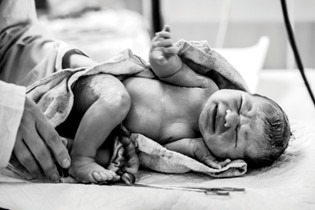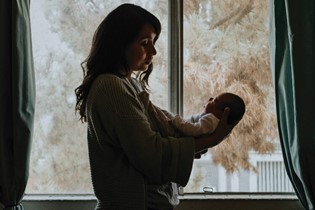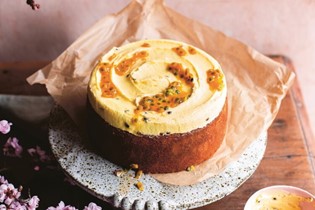We look at infant jaundice & the role of breastfeeding

Midwife, lactation consultant and mum of five, Stephanie Callaghan-Armstrong discusses the reasons behind infant jaundice and what role breastfeeding can have in the process.
When your newborn baby starts developing a ‘tan’ including the whites of their eyes, or occasionally 'oompah loompa' orange, neonatal jaundice is likely the cause. Infant jaundice, also named hyperbilirubinemia, is caused by a backlog of broken down red blood cells, called bilirubin, waiting to be processed by their immature liver. The build up of bilirubin in baby's blood turns their skin and mucous membranes different shades of yellow, due to its pigment. Physiological jaundice is said to be normal for up to 90 percent of newborn babies and is usually mild and harmless, and resolves on its own.
While in many cases there's no cause for concern or for medical intervention, it is helpful to understand why infant jaundice occurs, the different types, what to look out for and also how breastfeeding plays a significant role in helping it pass more quickly (and sometimes, interestingly, causes it too!).
There are 3 main types of infant jaundice. Physiological jaundice in newborns, pathological jaundice in newborns, and breast milk jaundice. Let’s unpack these…

PHYSIOLOGICAL JAUNDICE
The take home message about physiological, AKA ‘normal’ jaundice (the most common type), is that most of the time it’s indeed normal and no panic is needed. Early and frequent breastfeeding after baby is born and the choices you make for birth, such as pain relief and type of birth, can make a difference.
The increased bilirubin levels, even if not essentially harmful to baby, can make baby sleepy, making breastfeeding extra challenging; so it's good to act early. Physiological jaundice develops after 48 hours of birth and usually lasts around seven to 10 days.
Feeding baby your colostrum for their first feed after skin-to-skin, as close to birth as possible and frequently thereafter, is the perfect first step to helping prevent any serious effects of infant jaundice.
Bilirubin is reabsorbed through baby’s stools in the lower intestines especially those first black, sticky bilirubin-rich meconium stools. Regular breastfeeding helps the gut to pass this quicker and also the composition of colostrum helps create gut flora that also helps to break down bilirubin. It also aids gut motility to pass out meconium before it gets absorbed back into their system. It's the first time baby's immature gut has had to work and digest proteins, so colostrum is designed perfectly for this.
Breastfeeding baby every two to three hours from birth is recommended as colostrum and breast milk helps baby’s blood sugar levels to be maintained. If bilirubin levels are kept low, baby is less sleepy – which is good for establishing breast milk supply, among other things. Regular breastfeeding by way of nipple stimulation sends a message to your brain to make milk – it’s called supply and demand. The more you feed, the faster your breast milk establishes, and the bilirubin is then flushed out sooner.
Studies have shown that the medicines used in epidural anaesthesia, having a Caesarean section, an oxytocin drip to induce or augment labour, or an instrumental birth may also make baby more likely to have higher levels of jaundice. With epidurals and general anaesthesia (which occasionally is needed), the anaesthetic drugs pass through the placenta to baby and can affect the red blood cell breaking down process.

C-sections can also mean a delay in breastfeeding after birth because mum can take up to an hour or more to go through to the theatre recovery area before breastfeeding can happen. Most hospitals encourage baby-friendly practises now, where it’s possible for baby to be skin-to-skin in theatre after birth. It is also possible for baby to breastfeed in the biological prone position, skin-to-skin while mama is on the operating table, though in my experience as a lead maternity care (LMC) midwife, it's a bit tricky as the surgical drapes are there and positioning can be awkward. Babies also usually take a little while of enjoying the skin-to-skin closeness too before their rooting reflex (looking for the nipple) starts.
Mamas may like to hand-express some colostrum in the days leading up to a planned C-section, so baby can have a little feed via syringe before latching properly in recovery.
The other parent or birthing partner can also do skin-to-skin in the recovery ward while waiting for Mum to come through from theatre.
Babies born with an instrumental birth, which means with the assistance of a ventouse suction or forceps in the second stage, also have an increased jaundice risk due to bruising trauma and caput (swelling from the suction) to baby's head. The bruising causes a blood collection and the red blood cells to demise, increasing bilirubin levels that need processing by the liver.
There's the question too about delayed cord clamping that has become 'best practise' after birth. This is where there is a planned delay in the cord being cut after birth to give baby an extra 'transfusion' of blood as they kick into having their own blood circulation until the placenta separates. The benefits include increased blood volume and iron stores which is also very beneficial to the health of premature babies. It appears overall on studies that while initial blood bilirubin rates in babies may be higher than babies who haven't had delayed cord clamping, the overall treatment rates for serious jaundice are not increased; meaning overall it is beneficial.
Premature birth is also a risk factor for more severe physiological jaundice, needing treatment. The more prem that baby is born, the less mature the liver is, meaning it's less able to cope with the bilirubin levels it needs to process. You will often see tiny little babies being treated for jaundice in NICU units under blue lights. Again, early feeds of colostrum are optimal for prem babies as soon as they are able to orally feed. It may mean hand- expressing and giving milk by a syringe if baby isn't able to latch and suckle well yet (small amounts are all that's needed at first as babies tiny stomachs only have the capacity to hold 5-7 mls). Colostrum is low in volume but packed full of nutrients and antibodies and helps break down bilirubin.

PATHOLOGICAL JAUNDICE
There are other causes of infant jaundice that usually show up as symptoms in the first 24 hours of life – these are called pathological jaundice. This may be due to incompatibility of mum and baby's blood group which is called ABO incompatibility. With this, the mother develops antibodies against baby's incompatible blood type which attacks baby's red blood cells. Presenting similarly, is haemolytic disease where a rhesus blood group negative mum develops antibodies against her Rh positive baby. This jaundice can vary from mild to severe and is treated with phototherapy if the levels are above the treatment line. More serious forms of infant jaundice can also be from liver disease, infections or genetic conditions. Breast milk is very protective and healing for unwell babies.
BREAST MILK JAUNDICE
Breast milk jaundice on the other hand, can be caused – as it's named – by breast milk itself and arises usually between days 7-14 postpartum. It is thought that a substance in breast milk somehow interrupts the ability for baby's gut to absorb bilirubin and process it. It also may prevent proteins in the baby's liver from breaking down bilirubin. Usually it is mild and doesn't require treatment, and breastfeeding your slightly yellow baby can continue.
ASSESSMENT AND TREATMENT
A visual assessment of baby is the best initial way to figure out how a baby is doing with jaundice levels. A basic, undressed, head to toe assessment tells us a lot. The rule of thumb is that the higher the level of bilirubin, the lower down baby's body the yellowness is. Most babies with mild jaundice may have a pale yellow head and maybe chest but are still reasonably alert and vigorous for feeds. A baby with higher levels may have a very dark yellow or almost orange head and torso and some even go yellow down to their feet. They also would likely be very drowsy and difficult to wake – bilirubin is like a sleepy drug.
If it’s suspected that levels are high or baby may have other risk factors such as prematurity, or the jaundice starts before baby is 24 hours old (indicating that it may be pathological jaundice), a blood test is the next step. It’s the most accurate way to assess how high baby's bilirubin levels are and if any extra medical intervention is needed.
There are separate graphs for both term and prem babies to plot the results and a treatment line which assesses bilirubin levels correlating with how many hours old baby is. Medical phototherapy is indicated if the levels are above the line.
If you have seen a baby under different types of blue lights, that is phototherapy. They wear a little mask to protect baby's eyes and the UV light bleaches the bilirubin in the skin from a fat soluble to water soluble form so it bypasses the liver process.
The average treatment time is 48 hours and baby has daily blood tests to monitor that bilirubin levels are falling to the safe zone. Breastfeeding baby regularly during this time is very important to continue to help baby pass the bilirubin and also to prevent dehydration from the lights. Skin-to-skin, sometimes with a biliblanket (a blue light blanket that some hospitals have), can be a way to help reduce distress in baby and promote breastfeeding and bonding in the early days postpartum.
In very severe cases an exchange blood transfusion can be required to remove and then replace baby's blood when baby has pathological jaundice.
The UV light in sunlight also can be helpful when baby has less severe jaundice. Sunbathe baby in sunlight, undressed and on each side, being ultra-careful as too much sun can obviously be damaging to sensitive newborn skin. Just natural light through a window can be enough sometimes.
BREASTFEEDING DIET
Nutrition for breastfeeding mums is always very important because your milk is so nutrient-rich and requires a lot of energy to produce. Some experts also claim that when you have a breastfeeding baby with jaundice, certain foods and supplements are extra liver-supportive and will be passed onto baby through your milk. Try to eat plenty of the usual whole grains, protein-rich foods, fresh fruits and veges, lots of water, superfoods like broccoli and blueberries (antioxidants), mangos and papaya.
Supplements include milk thistle, a good breastfeeding multivitamin, fish oils, and vitamin C. Vitamins D and E are said to be beneficial in helping babies recover from jaundice, taken by mum and received through breast milk. Probiotics for the gut are also great for all breastfeeding mums.
Foods to avoid for breastfeeding mums of babies with jaundice include alcohol, processed salty, highly saturated fatty foods, sugar, fizzy drinks, white carbohydrates and 'junk foods' in general.
Remember most of the time infant jaundice is normal and requires no treatment. I hope you feel encouraged too that the benefits of breastfeeding baby and feeding soon after birth and every few hours thereafter (as the World Health Organisation code recommends) can significantly help prevent severe jaundice in your baby, along with the huge list of other benefits of course.
Ka pai mamas!
Stephanie Callaghan Armstrong is a mum of five, experienced lead maternity carer, midwife and lactation consultant and also runs a breast pump rental and sales business with husband, Dr Mikey from The Barnstead in Coatesville. Find her at babymed.co.nz, @babylove.midwife.life and @babymednz on Instagram.

AS FEATURED IN ISSUE 63 OF OHbaby! MAGAZINE. CHECK OUT OTHER ARTICLES IN THIS ISSUE BELOW

















